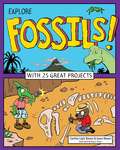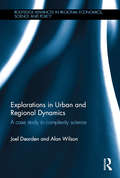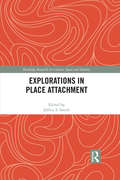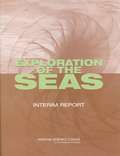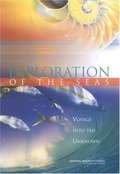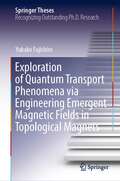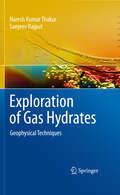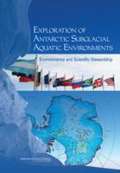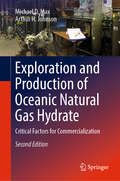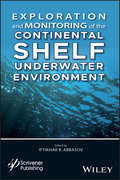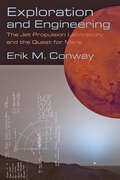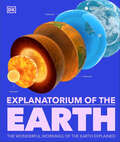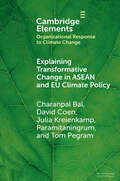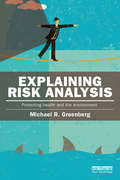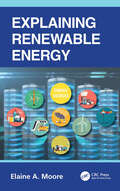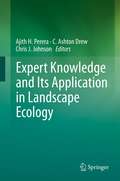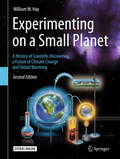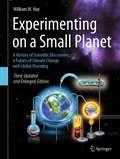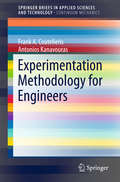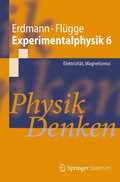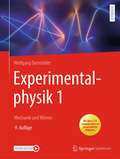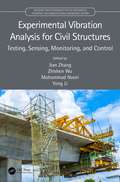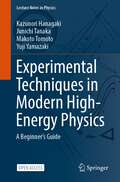- Table View
- List View
Explore Life Cycles!
by Kathleen M. Reilly Bryan StoneExplore Life Cycles! takes kids on an amazing journey, where they'll learn about the changes plants and animals experience throughout their lives. Kids ages 6-9 will discover what happens inside those magical cocoons to transform a caterpillar into a butterfly. They'll explore how frogs breathe underwater as tadpoles, then use lungs as an adult. Explore Life Cycles! will examine how plants and animals are born, develop, and live their lives.Activities range from creating edible life cycles of insects to making a mealworm nursery. Using an eye-catching combination of cartoons, fun facts, and exciting projects, Explore Life Cycles! will bring the mysteries of life right into kids' hands.
Explore Fossils!
by Cynthia Light Brown Grace BrownIn Explore Fossils! With 25 Great Projects, readers can expand their dinosaur obsessions into learning opportunities that take them beyond Triceratops, Stegosaurus, and even Tyrannosaurus rex to other animals, plants, and microbes that lived long before humans. Explore Fossils! introduces young readers to the history of life on Earth as revealed by fossils. Kids learn how fossils form and about the different types of fossils and the world of long ago--its landscape and the plants and animals that lived then. Scientists use radiometric dating to test fossils to discover when they were made, what organisms made them, what those organisms used for energy, what killed them, and a whole lot of other information. All from rocks! That's a lot of information stored under our feet. Activities include creating plaster fossils, using popcorn to illustrate radiometric dating, and exploring what might have caused mass extinctions by making a lava flow and simulating an asteroid impact. By studying the past, not only do students meet amazing plants and animals, they are also encouraged to consider their own role in geological time to make thoughtful hypotheses about the future.
Explorations in Urban and Regional Dynamics: A case study in complexity science (Routledge Advances in Regional Economics, Science and Policy)
by Joel Dearden Alan WilsonThe task of modelling the evolution of cities – the dynamics – is one of the major challenges of the social sciences. This book presents mathematical and computer models of urban and regional dynamics and shows how advances in computer visualisation provide new insights. Models of non-linear systems in general have three characteristics: multiple equilibria, ‘path dependence’ over time and phase transitions – that is, abrupt change at critical parameter values. These phenomena all exhibit themselves in reality, and it is an ongoing task to match model-based analysis with real phenomena. There are three key features of cities and regions to be represented in models: activities at a location – residence, health, education, work and shopping; flows between locations – spatial interaction; and the structures that carry these activities – buildings, transport and communications networks. Spatial interaction and many elements of activities’ location can be modelled by statistical averaging procedures, which are related to Boltzmann’s methods in statistical mechanics. This is while the evolution of structure can be represented in equations that connect to the Lotka-Volterra equations in ecology. Within this broad framework, alternative approaches can be brought to bear. This book uses entropy-maximising versions of spatial interaction models. The authors explore the dynamics in more detail, using advanced visualisation techniques. These ideas have wide potential uses, and the book illustrates this with applications in history and archaeology.
Explorations in Place Attachment (Routledge Research in Culture, Space and Identity)
by Jeffrey S SmithThe book explores the unique contribution that geographers make to the concept of place attachment, and related ideas of place identity and sense of place. It presents six types of places to which people become attached and provides a global range of empirical case studies to illustrate the theoretical foundations. The book reveals that the types of places to which people bond are not discrete. Rather, a holistic approach, one that seeks to understand the interactive and reinforcing qualities between people and places, is most effective in advancing our understanding of place attachment.
Exploration Seismology
by R. E. Sheriff L. P. GeldartThis is the completely updated revision of the highly regarded book Exploration Seismology. Available now in one volume, this textbook provides a complete and systematic discussion of exploration seismology. The first part of the book looks at the history of exploration seismology and the theory - developed from the first principles of physics. All aspects of seismic acquisition are then described. The second part of the book goes on to discuss data-processing and interpretation. Applications of seismic exploration to groundwater, environmental and reservoir geophysics are also included. The book is designed to give a comprehensive up-to-date picture of the applications of seismology. Exploration Seismology's comprehensiveness makes it suitable as a text for undergraduate courses for geologists, geophysicists and engineers, as well as a guide and reference work for practising professionals.
Exploration of the Seas: Interim Report
by Committee on Exploration of the SeasSeventy percent of our blue planet is covered by oceans. Although progress has been made in understanding the role of oceans in climate change, locating energy reserves, revealing new life forms, and describing the flow of carbon through these systems, it may be time to catapult our understanding to new levels by undertaking an interdisciplinary, international, global ocean exploration program. The interim report outlines the committee's vision for a future international global ocean exploration program; this vision will be fully described, together with detailed recommendations for technological needs and capabilities, funding levels, and management structures to ensure a productive and successful ocean exploration program.
Exploration Of The Seas: Voyage Into The Unknown
by Committee on Exploration of the SeasIn the summer of 1803, Thomas Jefferson sent Meriwether Lewis and William Clark on a journey to establish an American presence in a land of unqualified natural resources and riches. Is it fitting that, on the 200th anniversary of that expedition, the United States, together with international partners, should embark on another journey of exploration in a vastly more extensive region of remarkable potential for discovery. Although the oceans cover more than 70 percent of our planet’s surface, much of the ocean has been investigated in only a cursory sense, and many areas have not been investigated at all. Exploration of the Seas assesses the feasibility and potential value of implementing a major, coordinated, international program of ocean exploration and discovery. The study committee surveys national and international ocean programs and strategies for cooperation between governments, institutions, and ocean scientists and explorers, identifying strengths, weaknesses, and gaps in these activities. Based primarily on existing documents, the committee summarizes priority areas for ocean research and exploration and examines existing plans for advancing ocean exploration and knowledge.
Exploration of Quantum Transport Phenomena via Engineering Emergent Magnetic Fields in Topological Magnets (Springer Theses)
by Yukako FujishiroThis book addresses novel electronic and thermoelectronic properties arising from topological spin textures as well as topologically non-trivial electronic structures. In particular, it focuses on a unique topological spin texture, i.e., spin hedgehog lattice, emerging in a chiral magnet and explore its novel properties which are distinct from the conventional skyrmion lattice, and discusses the possibility of realizing high-temperature quantum anomalous Hall effect through quantum confinement effect in topological semimetal. This book benefits students and researchers working in the field of condensed matter physics, through providing comprehensive understanding of the current status and the outlook in the field of topological magnets.
Exploration of Gas Hydrates
by Naresh Kumar Thakur Sanjeev RajputGas hydrates are ice-like crystalline substances that form a rigid cage of water molecules and entrap hydrocarbon and non-hydrocarbon gas by hydrogen bonding. Natural gas hydrate is primarily composed of water and methane. These are solid, crystalline, ice-like substances found in permafrost areas and deepwater basins around the world. They naturally occur in the pore space of marine sediments, where appropriate high pressure and low temperature conditions exist in an adequate supply of gas (mainly methane). Gas hydrates are considered as a potential non conventional energy resource. Methane hydrates are also recognized as, an influence on offshore platform stability, a major factor in climate change contributing to global warming and a significant contribution to the ocean carbon cycle. The proposed book treats various geophysical techniques in order to quantify the gas hydrate reserves and their impact on environment. The primary goal of this book is to provide the state of art for gas hydrate exploration. The target audiences for this book are non-specialist from different branches of science, graduate students and researchers.
EXPLORATION OF ANTARCTIC SUBGLACIAL AQUATIC ENVIRONMENTS: Environmental and Scientific Stewardship
by National Research Council of the National AcademiesAntarctica is renowned for its extreme cold; yet surprisingly, radar measurements have revealed a vast network of lakes, rivers, and streams several kilometers beneath the Antarctic ice sheet. Sealed from Earth's atmosphere for millions of years, they may provide vital information about microbial evolution, the past climate of the Antarctic, and the formation of ice sheets, among other things. The next stage of exploration requires direct sampling of these aquatic systems. However, if sampling is not done cautiously, the environmental integrity and scientific value of these environments could be compromised. At the request of the National Science Foundation, this National Research Council assesses what is needed to responsibly explore subglacial lakes. Exploration of Antarctic Subglacial Aquatic Environments concludes that it is time for research on subglacial lakes to begin, and this research should be guided by internationally agreed upon protocols. The book suggests an initial protocol, which includes full characterization of the lakes by remote sensing, and minimum standards for biological and other types of contamination.
Exploration and Production of Oceanic Natural Gas Hydrate: Critical Factors For Commercialization
by Michael D. Max Arthur H. JohnsonThis second edition provides extensive information on the attributes of the Natural Gas Hydrate (NGH) system, highlighting opportunities for the innovative use and modification of existing technologies, as well as new approaches and technologies that have the potential to dramatically lower the cost of NGH exploration and production.Above all, the book compares the physical, environmental, and commercial aspects of the NGH system with those of other gas resources. It subsequently argues and demonstrates that natural gas can provide the least expensive energy during the transition to, and possibly within, a renewable energy future, and that NGH poses the lowest environmental risk of all gas resources.Intended as a non-mathematical, descriptive text that should be understandable to non-specialists as well as to engineers concerned with the physical characteristics of NGH reservoirs and their production, the book is written for readers at the university graduate level. It offers a valuable reference guide for environmentalists and the energy community, and includes discussions that will be of great interest to energy industry professionals, legislators, administrators, regulators, and all those concerned with energy options and their respective advantages and disadvantages.
Exploration and Monitoring of the Continental Shelf Underwater Environment
by Iftikhar B. AbbasovThere is still so much about the oceans that scientists do not know, and exploring the continental shelves of the world is a huge part of finding out more about these underwater environments. Further to that, it is extremely important that, while scientists and engineers explore and monitor the continental shelf, no damage is done to these precious environments. That is the needle that this study intends to thread, giving scientists and engineers a better method and processes for exploring these underwater mysteries, while protecting the environment and wildlife thriving beneath. Written by a proven scientist in this area, this book is dedicated to the unique developments of hydroacoustical equipment to monitor the coastal shelf. The results of the original experimental sonar studies with application of the parametric antenna are presented. The book presents a survey of the modern methods and technical monitoring facilities of the coastal aqueous environment. The basic characteristics of the parametric antennas are given considering propagation of the acoustic waves in the environments with dispersion and acoustical absorption. The author and his colleagues consider the questions of formation of the parametric antenna field in layered-heterogeneous media and the peculiarities of sounding of the interfaces and bottom sediments. Ecological monitoring methods of the basic parameters of quality and condition of the aqueous environment are analyzed. The peculiarities of diagnostics of the underwater engineering constructions when monitoring the offshore strips are described. For both veteran engineers and students in the field alike, this breakthrough study is a must-have for any scientific library concerned with studying the oceans and especially the continental shelf.
Exploration and Engineering: The Jet Propulsion Laboratory and the Quest for Mars (New Series in NASA History)
by Erik M. ConwayGetting to Mars required engineering genius, scientific strategy, and the drive to persevere in the face of failure.Although the Jet Propulsion Laboratory in Pasadena, California, has become synonymous with the United States’ planetary exploration during the past half century, its most recent focus has been on Mars. Beginning in the 1990s and continuing through the Mars Phoenix mission of 2007, JPL led the way in engineering an impressive, rapidly evolving succession of Mars orbiters and landers, including roving robotic vehicles whose successful deployment onto the Martian surface posed some of the most complicated technical problems in space flight history.In Exploration and Engineering, Erik M. Conway reveals how JPL engineers’ creative technological feats led to major breakthroughs in Mars exploration. He takes readers into the heart of the lab’s problem-solving approach and management structure, where talented scientists grappled with technical challenges while also coping, not always successfully, with funding shortfalls, unrealistic schedules, and managerial turmoil.Conway, JPL’s historian, offers an insider’s perspective into the changing goals of Mars exploration, the ways in which sophisticated computer simulations drove the design process, and the remarkable evolution of landing technologies over a thirty-year period.
Explanatorium of the Earth (DK Explanatorium)
by DKWelcome to the Explanatorium of the Earth - the only Earth encyclopedia for children you'll ever need, with amazing photographs of everything from supervolcanoes to tsunamis.What makes volcanoes erupt? Why are tornadoes and hurricanes so destructive? How do rocks, fossils, and gems form? Explanatorium of the Earth takes you on an incredible voyage deep into the heart of our planet and back to discover the powerful forces that continually shape and remodel our ever-changing world. Discover how tectonic plates tear apart and collide, moving inch by inch to create continents, mountain ranges, oceans, and volcanoes. Witness the destructive power of earthquakes, tsunamis, and hurricanes. Learn how the slow but relentless process of erosion and weathering wear away rock, reducing mountains to dust and carving valleys and canyons into the land. And learn how the living world and rock cycles have worked together for millions of years to stabilize the planet's climate, keeping Earth suitable for life.
Explaining Transformative Change in ASEAN and EU Climate Policy: Multilevel Problems, Policies and Politics (Organizational Response to Climate Change: Businesses, Governments)
by Charanpal Bal David Coen Julia Kreienkamp Paramitaningrum Tom PegramThe Paris Agreement embodies a flexible approach to global cooperation, aimed at encouraging ever more ambitious climate action by a variety of players on all levels of governance. Regional organizations play an important role in mobilizing such action. This Element provides novel insights into the conditions under which policy entrepreneurs can bring about transformative policy change in regional settings, with a focus on the European Union (EU) and the Association of Southeast Asian Nations (ASEAN). It finds that opportunity structures in the EU have been conducive to successful climate-progressive policy entrepreneurship at several key junctures, but not consistently. In contrast, the ASEAN governance context provides few access points for non-elite interests, making it fiendishly difficult for policy entrepreneurs to push for substantive policy change in the face of powerful domestic veto players. This title is also available as Open Access on Cambridge Core.
Explaining Risk Analysis: Protecting health and the environment (Earthscan Risk in Society)
by Michael R GreenbergRisk analysis is not a narrowly defined set of applications. Rather, it is widely used to assess and manage a plethora of hazards that threaten dire implications. However, too few people actually understand what risk analysis can help us accomplish and, even among experts, knowledge is often limited to one or two applications. Explaining Risk Analysis frames risk analysis as a holistic planning process aimed at making better risk-informed decisions and emphasizing the connections between the parts. This framework requires an understanding of basic terms, including explanations of why there is no universal agreement about what risk means, much less risk assessment, risk management and risk analysis. Drawing on a wide range of case studies, the book illustrates the ways in which risk analysis can help lead to better decisions in a variety of scenarios, including the destruction of chemical weapons, management of nuclear waste and the response to passenger rail threats. The book demonstrates how the risk analysis process and the data, models and processes used in risk analysis will clarify, rather than obfuscate, decision-makers’ options. This book will be of great interest to students and scholars of risk assessment, risk management, public health, environmental science, environmental economics and environmental psychology.
Explaining Renewable Energy
by Elaine A. MooreThis undergraduate text aimed primarily at high schoolers and lower level undergraduates focuses on explaining how the various forms of renewable energy work and the current ongoing research. It includes sections on non-scientific aspects that should be considered such as availability of resources. A final chapter covers methods of removing carbon dioxide from the atmosphere.Renewable energy is currently on everyone’s mind in the context of climate change. This text provides students with an introduction into the science behind the various types of renewable energy enabling them to access review literature in the field and options that that should be considered when selecting methods. Features Collates the most relevant and up to date information on renewable energy systems in a user friendly format for undergraduate and high school students. Focuses on power production technologies from renewable energy sources. An introduction to how sources of renewable energy work; their advantages and drawbacks. Timely text with the need for fast adoption of renewable energy technologies around the world. Suitable for a diverse audience including students with some scientific background such as final year in high school wanting to know more about combatting climate change.
Expert Knowledge and Its Application in Landscape Ecology
by Chris J. Johnson Ajith H. Perera C. Ashton DrewTypically, landscape ecologists use empirical observations to conduct research and devise solutions for applied problems in conservation and management. In some instances, they rely on advice and input of experienced professionals in both developing and applying knowledge. Given the wealth of expert knowledge and the risks of its informal and implicit applications in landscape ecology, it is necessary to formally recognize and characterize expert knowledge and bring rigor to methods for its applications. In this context, the broad goal of this book is to introduce the concept of expert knowledge and examine its role in landscape ecological applications. We plan to do so in three steps: First we introduce the topic to landscape ecologists, explore salient characteristics of experts and expert knowledge, and describe methods used in capturing and formalizing that knowledge. Second, we present examples of research in landscape ecology from a variety of ecosystems and geographic locations that formally incorporate expert knowledge. These case studies address a range of topics that will interest landscape ecologists and other resource management and conservation professionals including the specific roles of expert knowledge in developing, testing, parameterizing, and applying models; estimating the uncertainty in expert knowledge; developing methods of formalizing and incorporating expert knowledge; and using expert knowledge as competing models and a source of alternate hypotheses. Third, we synthesize the state of knowledge on this topic and critically examine the advantages and disadvantages of incorporating expert knowledge in landscape ecological applications. The disciplinary subject areas we address are broad and cover much of the scope of contemporary landscape ecology, including broad-scale forest management and conservation, quantifying forest disturbances and succession, conservation of habitats for a range of avian and mammal species, vulnerability and conservation of marine ecosystems, and the spread and impacts of invasive plants. This text incorporates the collective experience and knowledge of over 35 researchers in landscape ecology representing a diverse range of disciplinary subject areas and geographic locations. Through this text, we will catalyze further thought and investigations on expert knowledge among the target readership of researchers, practitioners, and graduate students in landscape ecology.
Experimenting on a Small Planet
by William W. HayThis book is a thorough introduction to climate science and global change. The author is a geologist who has spent much of his life investigating the climate of Earth from a time when it was warm and dinosaurs roamed the land, to today's changing climate. Bill Hay takes you on a journey to understand how the climate system works. He explores how humans are unintentionally conducting a grand uncontrolled experiment which is leading to unanticipated changes. We follow the twisting path of seemingly unrelated discoveries in physics, chemistry, biology, geology, and even mathematics to learn how they led to our present knowledge of how our planet works. He explains why the weather is becoming increasingly chaotic as our planet warms at a rate far faster than at any time in its geologic past. He speculates on possible future outcomes, and suggests that nature itself may make some unexpected course corrections. Although the book is written for the layman with little knowledge of science or mathematics, it includes information from many diverse fields to provide even those actively working in the field of climatology with a broader view of this developing drama. Experimenting on a Small Planet is a must read for anyone having more than a casual interest in global warming and climate change - one of the most important and challenging issues of our time.
Experimenting on a Small Planet: A History of Scientific Discoveries, a Future of Climate Change and Global Warming
by William W. HayThis book is a thorough introduction to climate science and global change. The author is a geologist who has spent much of his life investigating the climate of Earth from a time when it was warm and dinosaurs roamed the land, to today's changing climate. Bill Hay takes you on a journey to understand how the climate system works. He explores how humans are unintentionally conducting a grand uncontrolled experiment which is leading to unanticipated changes. We follow the twisting path of seemingly unrelated discoveries in physics, chemistry, biology, geology, and even mathematics to learn how they led to our present knowledge of how our planet works. He explains why the weather is becoming increasingly chaotic as our planet warms at a rate far faster than at any time in its geologic past. He speculates on possible future outcomes, and suggests that nature itself may make some unexpected course corrections. Although the book is written for the layman with little knowledge of science or mathematics, it includes information from many diverse fields to provide even those actively working in the field of climatology with a broader view of this developing drama. Experimenting on a Small Planet is a must read for anyone having more than a casual interest in global warming and climate change - one of the most important and challenging issues of our time. This new edition includes actual data from climate science into 2021. Numerous Powerpoint slides can be downloaded to allow lecturers and teachers to more effectively use the book as a basis for climate change education.
Experimentation Methodology for Engineers (SpringerBriefs in Applied Sciences and Technology)
by Frank A. Coutelieris Antonios KanavourasThis book delivers a methodological approach on the experimentation and/or simulation processes from the disclaiming hypothesis on a physical phenomenon to the validation of the results. The main benefit of the book is that it discusses all the topics related to experimentation and validation of the outcome including state-of-the-art applications and presents important theoretical, mathematical and experimental developments, providing a self-contained major reference that is appealing to both the scientists and the engineers. At the same time, these topics are encountered in a variety of scientific and engineering disciplines. As a first step, it presents the theoretical and practical implications on the formation of a hypothesis, considering the existing knowledge collection, classification and validation of the particular areas of experimenting interest. Afterwards, the transition from the knowledge classes to the experimentation parameters according to the phenomena evolution contributors and the systemic properties of the descriptors are discussed. The major experimenting requirements focus on the conditions to satisfy a potential disclaim of the initial hypothesis as conditions. Furthermore, the experimentation outcome, as derived via the previous experimentation process set-up, would be validate for the similarities among the existing knowledge and derived new one. The whole methodology offers a powerful tool towards the minimization of research effort wastes, as far as it can identify the lacks of knowledge, thus the areas of interest where the current research has to work on. The special features of this book are (a) the use of state-of-the-art techniques for the classification of knowledge, (b) the consideration of a realistic systemic world of engineering approached phenomena, (c) the application of advanced mathematical techniques for identifying, describing and testing the similarities in the research results and conclusions, and (d) the experimental investigation of relevant phenomena.
Experimentalphysik 6: Elektrizität, Magnetismus Physik
by Martin Erdmann Günter FlüggeUm Naturvorgänge beobachten, erklären und vorherzusagen zu können, ist die Physik auf fundierte Kenntnisse der experimentellen Methoden, der Interpretation von Messungen und der physikalischen Konzepte angewiesen. Diese werden auf Basis der Mathematik entwickelt. Der Autor vermittelt Physik-Studierenden im Bachelor-Studium die wesentlichen Konzepte und die experimentellen Methoden zu deren Überprüfung. Studierende sollen lernen, die entsprechenden mathematischen Berechnungen anzustellen. Mit Beispielen, Aufgaben und Beschreibungen von Experimenten.
Experimentalphysik 1: Mechanik und Wärme (Springer-Lehrbuch)
by Wolfgang DemtröderDas vorliegende Lehrbuch zur Mechanik und Wärmelehre richtet sich an Studierende der Physik im ersten Semester. Die Vorlesungsinhalte werden hier anschaulich, übersichtlich und leicht verständlich in zwölf Kapiteln dargestellt: Das Buch beginnt mit der Mechanik des Massenpunktes, Bezugssystemen und spezielle Relativitätstheorie. Es werden Systeme von Massenpunkten und die Dynamik starrer ausgedehnter Körper behandelt. Anschließend wird das Verhalten von festen und flüssigen realen Körpern und Gasen diskutiert. Strömende Flüssigkeiten und Gase, Auftrieb und die Physik des Fliegens werden im nächsten Kapitel besprochen. Nach der Vakuum-Physik wird die Wärmelehre eingeführt. Das Buch endet mit mechanischen Schwingungen und Wellen, nichtlinearer Dynamik und Chaos. Für das Verständnis notwendige Teilaspekte der Mathematik werden im Anhang aufgeführt. Ganz im Stil der bekannten Reihe zur Experimentalphysik von Professor Demtröder wird auch die Mechanik und Wärmelehre möglichst quantitativ präsentiert. Wichtige Formeln und Merksätze sind hervorgehoben und der Lernstoff direkt anhand von Beispielen verständlich gemacht. Über 160 Übungsaufgaben werden ausführlich gelöst und Zusammenfassungen unterstützen Studierende beim strukturierten Lernen. In der neunten Auflage des beliebten Lehrbuches erwartet Leserinnen und Leser jetzt zusätzlich: o Wichtige und grundlegende Aufgaben werden in Videos klar und verständlich besprochen und ausführlich an der Tafel gelöst. o Kurze Fragen am Anfang der Kapitel stimmen auf das jeweilige Themengebiet ein und machen neugierig, beispielsweise: Woher wissen wir, dass die Lichtgeschwindigkeit konstant und unabhängig von der Bewegung des Beobachters ist? Was ist ein Trägheitsmoment eines Körpers und wie unterscheidet es sich von der Masse des Körpers? Wovon hängt es ab, ob Materie fest, flüssig oder gasförmig ist? Wie kommt eine Seifenblase zustande? o Ein neues Layout präsentiert den Inhalt noch übersichtlicher. o Ausgesuchte Abbildungen stehen als Vorlesungsfolien für Dozentinnen und Dozenten zur Verfügung. Der Autor Wolfgang Demtröder studierte an den -Universitäten in Münster, Tübingen und Bonn die Fächer Physik, Mathematik und Musikwissenschaft. Dort promovierte er bei dem späteren Nobelpreisträger Prof. Wolfgang Paul. Er arbeitete an der Universität Freiburg als wissenschaftlicher Mitarbeiter, wo er auch habilitiert wurde und forschte als Visiting Fellow am Joint Institute for Astrophysics in Boulder, Colorado und erhielt 1970 einen Ruf als ordentlicher Professor an die Universität Kaiserslautern. Er forschte unter anderem auf dem Gebiet der hochauflösenden Laserspektroskopie kleiner Moleküle. Bekannt ist der Autor vor allem für sein Standardwerk über Laserspektroskopie und seine beliebte und bekannte Lehrbuchreihe Experimentalphysik I-IV.
Experimental Vibration Analysis for Civil Structures: Testing, Sensing, Monitoring, and Control (Resilience and Sustainability in Civil, Mechanical, Aerospace and Manufacturing Engineering Systems)
by Jian Zhang, Zhishen Wu, Mohammad Noori, and Yong LiExperimental Vibration Analysis for Civil Structures: Testing, Sensing, Monitoring, and Control covers a wide range of topics in the areas of vibration testing, instrumentation, and analysis of civil engineering and critical infrastructure. It explains how recent research, development, and applications in experimental vibration analysis of civil engineering structures have progressed significantly due to advancements in the fields of sensor and testing technologies, instrumentation, data acquisition systems, computer technology, computational modeling and simulation of large and complex civil infrastructure systems. The book also examines how cutting-edge artificial intelligence and data analytics can be applied to infrastructure systems. Features: Explains how recent technological developments have resulted in addressing the challenge of designing more resilient infrastructure Examines numerous research studies conducted by leading scholars in the field of infrastructure systems and civil engineering Presents the most emergent fields of civil engineering design, such as data analytics and Artificial Intelligence for the analysis and performance assessment of infrastructure systems and their resilience Emphasizes the importance of an interdisciplinary approach to develop the modeling, analysis, and experimental tools for designing more resilient and intelligent infrastructures Appropriate for practicing engineers and upper-level students, Experimental Vibration Analysis for Civil Structures: Testing, Sensing, Monitoring, and Control serves as a strategic roadmap for further research in the field of vibration testing and instrumentation of infrastructure systems.
Experimental Techniques in Modern High-Energy Physics: A Beginner‘s Guide (Lecture Notes in Physics #1001)
by Kazunori Hanagaki Junichi Tanaka Makoto Tomoto Yuji YamazakiThis open access book offers a concise overview of how data from large scale experiments are analyzed and how technological tools are used in practice, as in the search for new elementary particles. It focuses on interconnects between physics and detector technology in experimental particle physics, and includes descriptions of mathematical approaches. Readers find all the important steps in analysis, including reconstruction of the momentum and energy of particles from detector information, particle identification, and also the general concept of simulating particle production from collisions and detector responses. As the scale of scientific experiments becomes larger and data-intensive science emerges, the techniques used in the data analysis become ever more complicated, making it difficult for beginners to grasp the overall picture. The book provides an explanation of the idea and concepts behind the methods, helping readers understand journal articles on high energy physics. This book is engaging as it does not overemphasize mathematical formalism and it gives a lively example of how such methods have been applied to the Higgs particle discovery in the Large Hadron Collider (LHC) experiments, which led to Englert and Higgs being awarded the Nobel Prize in Physics for 2013.Graduate students and young researchers can easily obtain the required knowledge on how to start data analyses from these notes, without having to spend time in consulting many experts or digesting huge amounts of literature.

